Garlic Scape Relish is made with fresh early summer garden grown garlic scapes. With just the right amount of vinegar and a touch of dill, it’s perfect on hot dogs, burgers, sandwiches, and mixed into macaroni salad.
Looking for a new flavour for your next backyard barbecue? Forget ketchup and mustard, Garlic Scape Relish is where it’s at! Packed with dill-icious garlic flavour, it’s like garlic dill pickles on steroids. It is outstanding on Smoked Bison Burgers or as a flavour boost for macaroni and potato salads.
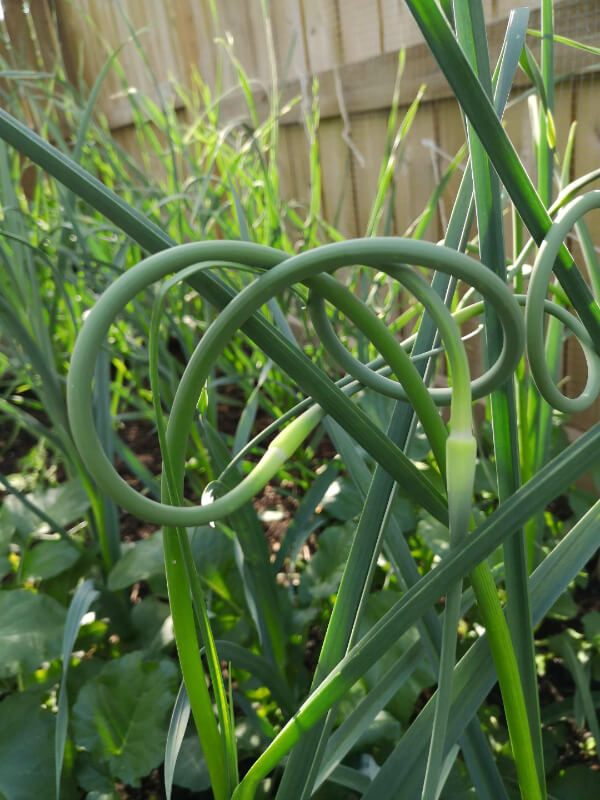
Want to save this recipe?
Enter your email below and get this post sent straight to your inbox. Plus, I’ll send you my weekly newsletter featuring the newest and best Dish ‘n’ the Kitchen recipes every week!
Garden Fresh Garlic
Growing your own garlic is one of life’s simple pleasures. Nothing compares to slicing into amazing fresh garlic right out of the ground. The flavour and freshness is far superior to any garlic you can buy from a grocery store. There are two kinds of garlic (soft and hard necked) but only one provides two harvests during the growing season.
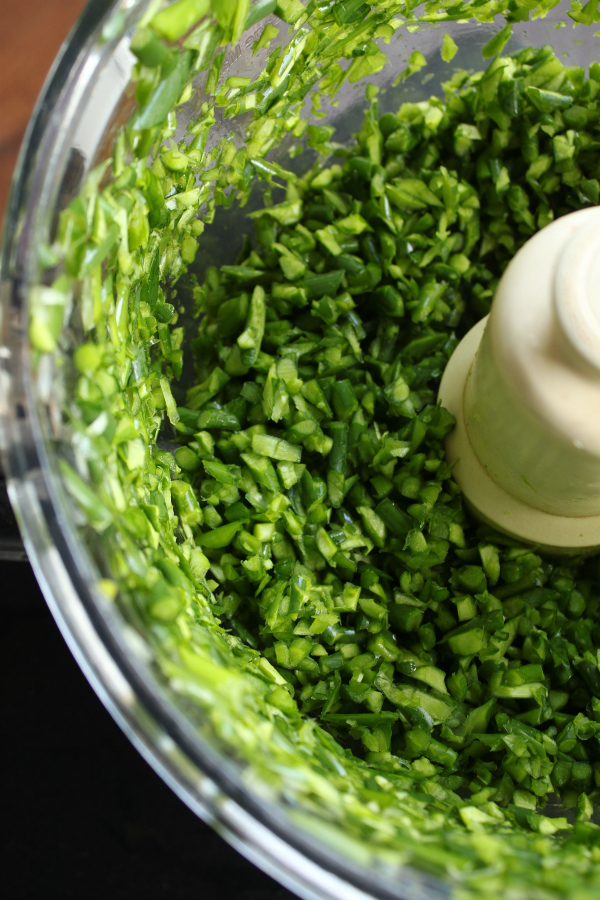
Hard necked garlic is planted in the fall and begins growing as soon as the snow clears in the Spring. The bulbs split open and green shoots burst forth. As the garlic grows taller, Spring turns to Summer and a thick tubular shoot, or scape appears from between the green leaves.
What Are Garlic Scapes?
The scape is a stalk that holds the flowering body of the garlic. It grows straight at first but eventually begins to coil. While it grows, it uses up a fair amount of plant energy in order to produce the stalk, flower, then seeds.
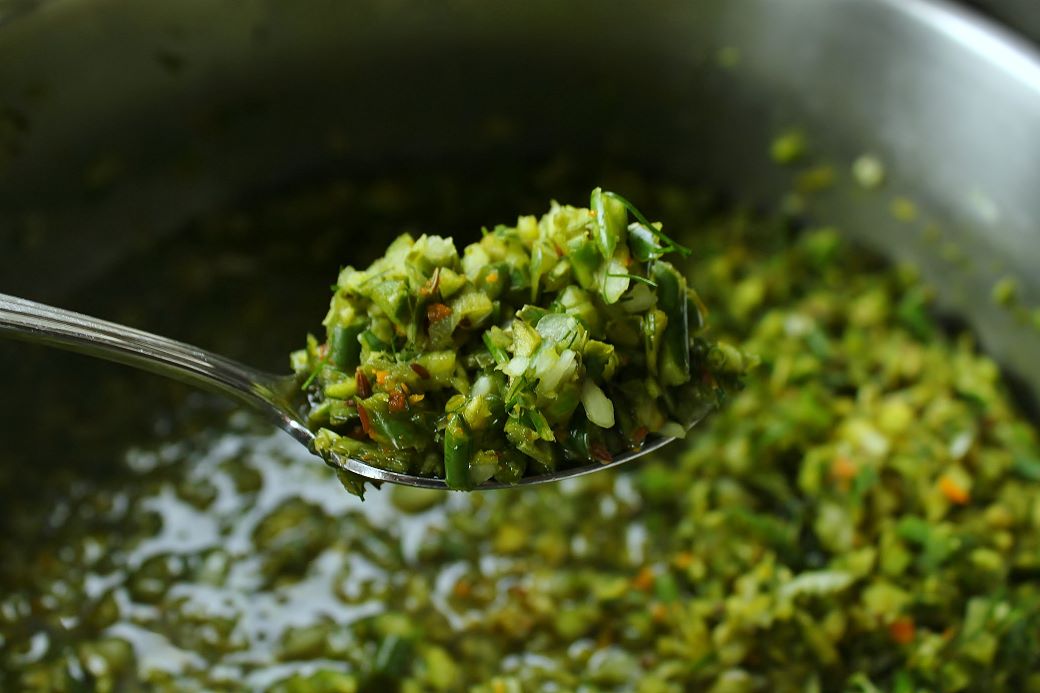
In order for the bulb to reach it’s full potential in size and flavour, the scape must be cut off. This allows the plant energy to shift towards the bulb (the second and final harvest). As a rule, garlic scapes should be harvested once the centre stalk is fully formed and begins to spiral. To harvest, cut the stalk as far down as you can without damaging the leaves.
What Do Garlic Scapes Taste Like?
Luckily, the solid scape stalk is tender and quite delicious when cooked. The flavour is a combination of onions, scallions and garlic, though the flavour is milder and ‘greener’ than just garlic on it’s own. There are so many ways to enjoy this garlicky treat!
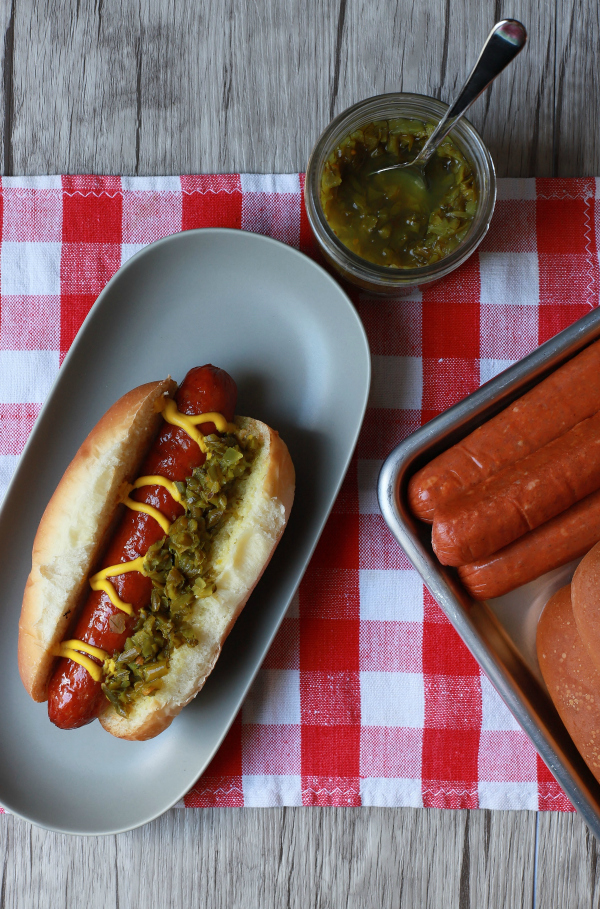
How to Find and Store Garlic Scapes
If you aren’t able to grow your own garlic, scapes can sometimes be difficult to come by because they are around for such a short time. Some places you may find garlic scapes are:
- Asian grocery stores in the produce section.
- Farmer’s Markets.
- Direct from a farmer. Last year I bought 9 lbs of garlic scapes just so I could make several batches of this Garlic Scape Relish.
Once you find them, scapes are quite hardy and will keep for a few weeks in the fridge crisper or many months in the freezer.
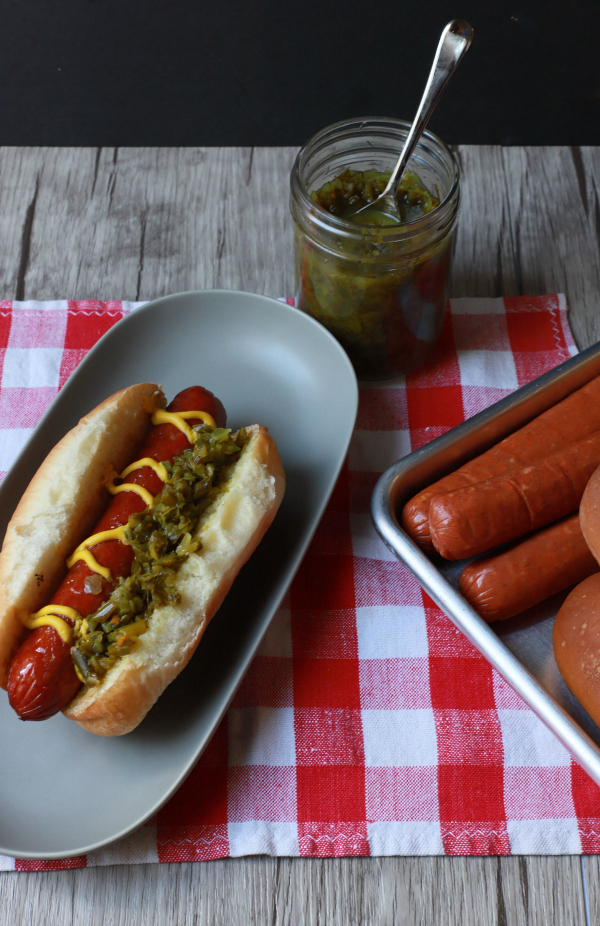
Great Ways to Eat Garlic Scapes
Garlic scapes are very versatile and can be used in the same way as garlic and scallions (green onions). To use, trim off the bulb and wash the stem. Chop it up and it’s ready to be steamed, grilled, roasted, puréed, dried, sautéed, and pickled. Though they can be eaten raw, though the larger stalks may become quite tough. Some great uses for Garlic Scapes are:
- in a stir fry
- chopped in an omelette
- in soups and stews
- added to hummus
- mixed with butter to make a compound butter
- roasted and eaten as a vegetable
- used in a salad dressing
- in a pesto then used on baked potatoes, macaroni or potato salad, or in a pasta dish.
- pickled whole or as a Garlic Scape Relish
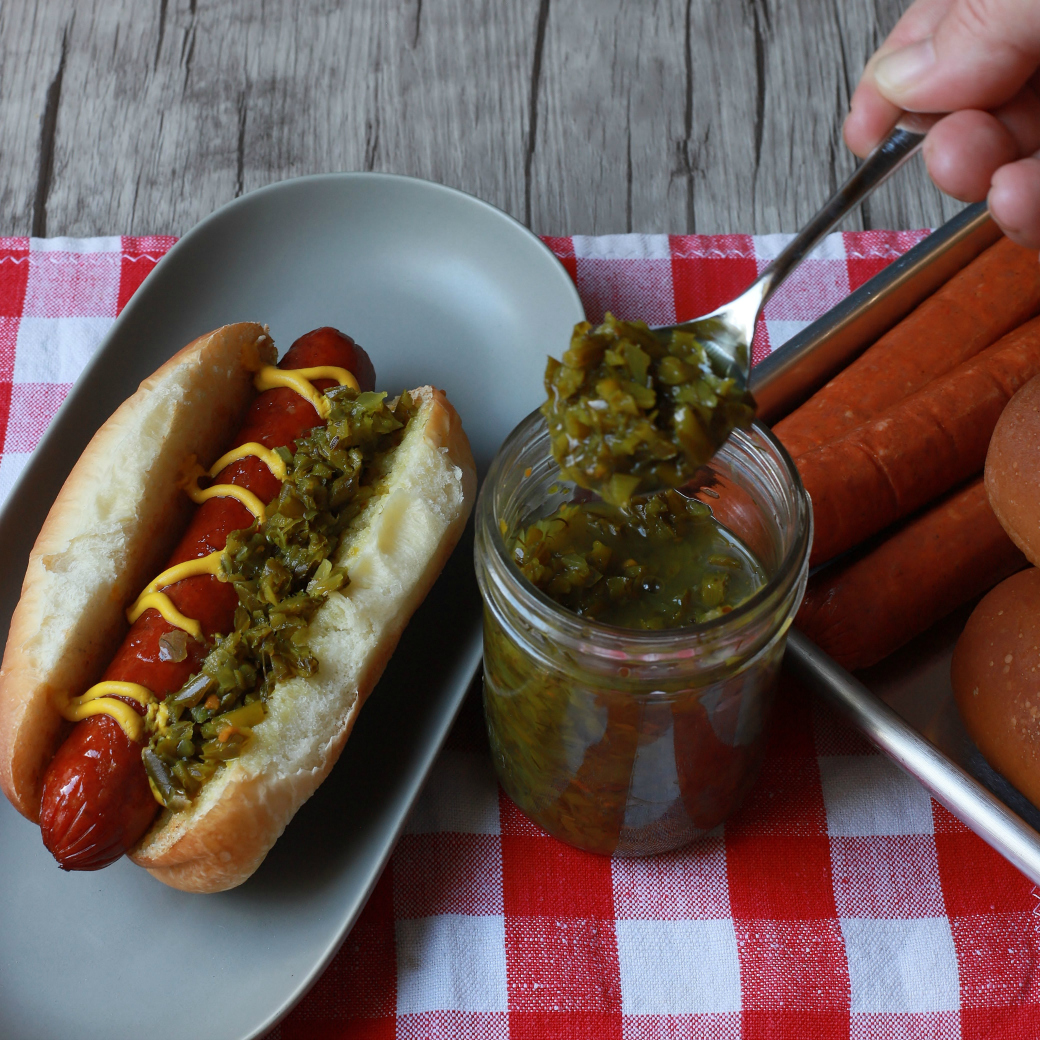
How To Make Garlic Scape Relish
This recipe is a bit of work. If you have a food processor, I highly recommend using it to cut the onions and scapes. To simplify things, I’ve split the entire process into three distinct steps.
- Prepping the Garlic Scape Relish
- Getting canning equipment ready
- Hot Water Processing
To prep the Garlic Scape Relish, blitz the onions and scapes in a food processor in batches until they are your preferred relish size. Place them in a large pot or Dutch oven, then add the remainder of ingredients omitting gochugaru if you don’t want spicy relish.
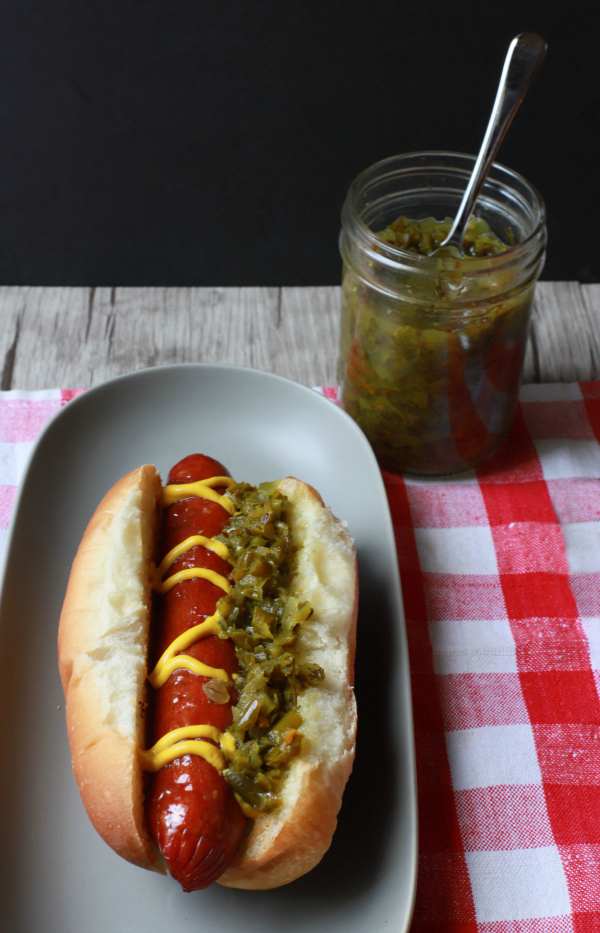
Next, get the canning equipment ready. Fill a hot water canner with hot water, add the rack, and set it to boil. Wash and inspect the jars, metal rings, and lids. Place the jars upside down in a tray of water placed in a 225 F oven for at least 10 minutes. Heat the metal rings and lids in a pot of simmering water.
Once the equipment is ready, slowly simmer the relish for at least ten minutes or until it has softened slightly. Add extra vinegar if it begins to look dry.
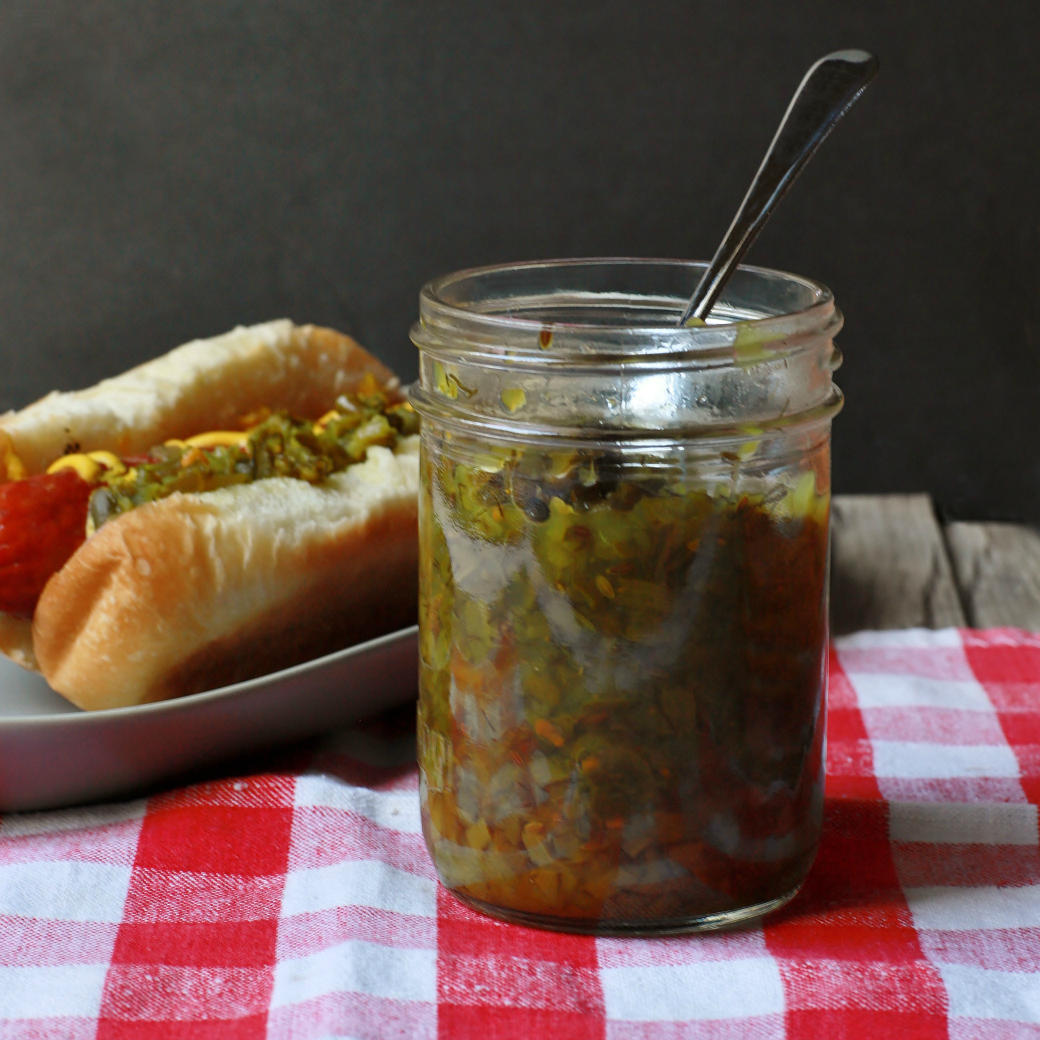
Filling and Processing Garlic Scape Relish
To process, take two hot jars out of the oven, fill them with hot relish and top up with a bit of vinegar (if needed), leaving about 1 cm of head space. Lightly tap the jars on the counter top to remove any air bubbles and add more vinegar, if needed.
Wipe the jar rim, top with a lid and fasten the ring just slightly but not too tightly. Place the jar in the rack of the hot water canner. Repeat with remaining relish. Once there are enough jars to fill the canner, process for 15 minutes or more at a rolling boil, depending on your elevation. Here in Calgary, Alberta I processed these 250 ml jars for 25 minutes.
Remove jars from the boiling water and allow to cool. Repeat the process with any remaining jars of relish. Allow to cool and listen for the characteristic lid ‘pop’ which means the jars have sealed. Do not disturb for 12 hours.
How to Store Garlic Scape Relish
Store sealed jars of scape relish in a cool, dark basement for up to a year. Once opened, store for up to two months in a refrigerator. Do not consume if the relish has any visible mold, ‘off’ smell, or effervescence. When in doubt, throw it out.
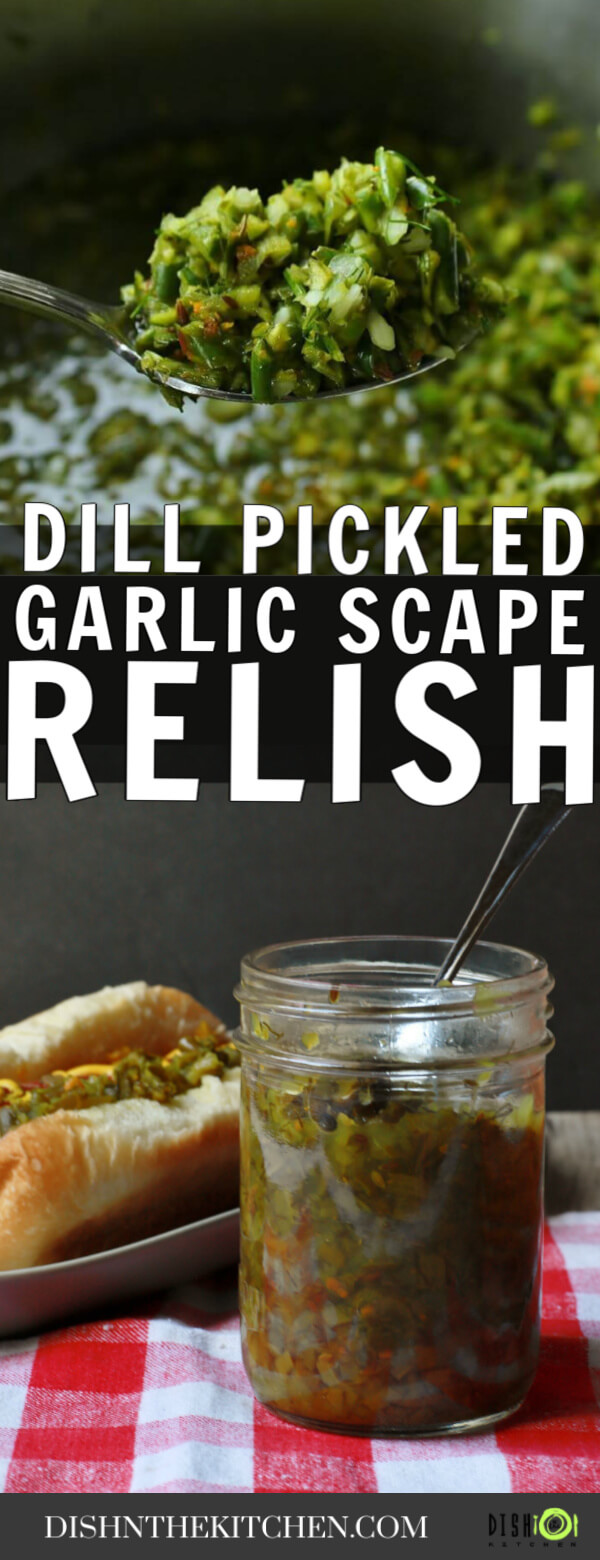
Dill-icious Garlic Scape Relish
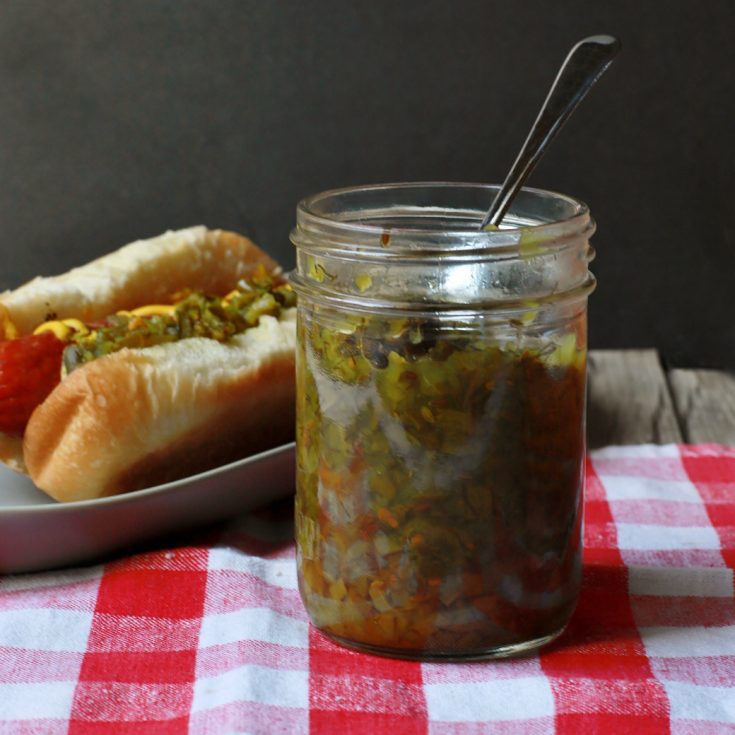
Garlic Scape Relish is made with fresh early summer garden grown garlic scapes. With just the right amount of vinegar and a touch of dill, it's perfect on hotdogs, burgers, sandwiches, and mixed into macaroni salad.
Ingredients
- 2 lbs fresh garlic scapes
- 2 cups roughly chopped onions; about 3 medium
- 3 tsp fresh turmeric
- 1/2 cup plus 2 tbsp kosher salt
- 1/3 cup sugar
- 3 tsp dill weed
- 1 cup fresh dill weed; chopped
- 4 cups white vinegar
- 1 1/2 tbsp gochugaru (if using)
Instructions
Prepping the Garlic Scape Relish
- Process onions in food processor until they become your desired size.
- Wash and slightly chop scapes, then process in batches until they reach a similar size as the onions.
- Add onions and scapes to a Dutch oven, add remainder of ingredients omitting gochugaru if you don't want spicy relish.
Getting Canning Equipment Ready
- Fill a large canner with hot water and bring to a boil.
- Wash and sterilize jars by placing them upside down in a tray of water and leaving them in a 225 F oven for at least 10 minutes.
- Wash and place jar lids and rings in a large saucepan and cover with water.
Hot Water Processing
- When the lids, jars, and utensils are all ready to go, then simmer the pot of scapes for at least ten minutes. There should be liquid so if it looks dry, feel free to add more vinegar as needed.
- Once you are ready to jar the relish, take two hot jars out of the oven, fill them and top up with a bit of vinegar. Leave about 1 cm of headspace.
- Tap the jars on the counter top to remove any air bubbles and add more vinegar if needed. Quickly top with a lid and fasten the ring just slightly, not too tightly.
- Place each filled jar in the rack of the canner, then lower it into the boiling water when there's no more room for jars.
- You may need to remove water to prevent over flowing as the water boils or you may need to add boiling water to ensure the jars are covered with at least an inch of water at all times. It's a good idea to keep a kettle of boiling water on while hot water canning.
- Process for 15 minutes or more, depending on your elevation. Here in Calgary, Alberta I processed these 250 ml jars for 25 minutes at a rolling boil.
- Remove from boiling water and allow to cool. Do not disturb for 12 hours.
Notes
*each jar contains 1/2 pint 250 ml relish and is 408 calories in total.
You will probably need to do two hot water cycles for this recipe. That's fine, just keep the jars, lids and relish hot until it's time to fill the second batch of jars. This is also a great time to add gochugaru to the other half of the recipe if you like.
Nutrition Information:
Yield:
10Serving Size:
1Amount Per Serving: Calories: 408Total Fat: 1gSaturated Fat: 0gTrans Fat: 0gUnsaturated Fat: 0gCholesterol: 0mgSodium: 1415mgCarbohydrates: 95gFiber: 3gSugar: 63gProtein: 7g
Nutritional calculation was provided by Nutritionix and is an estimation only. For special diets or medical issues please use your preferred calculator.

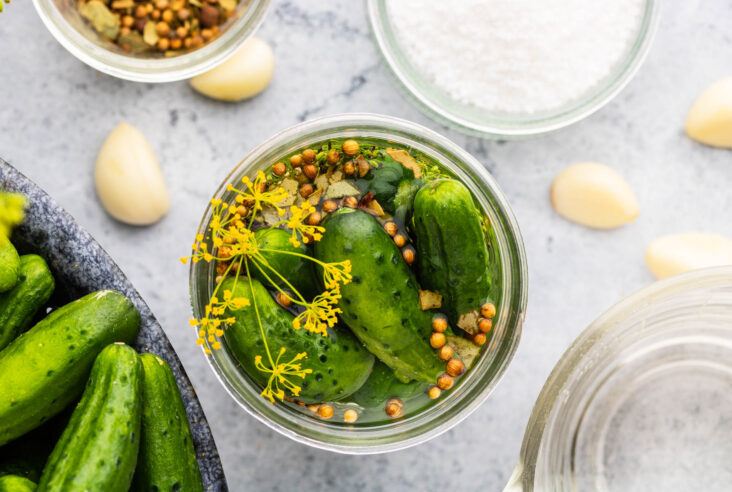
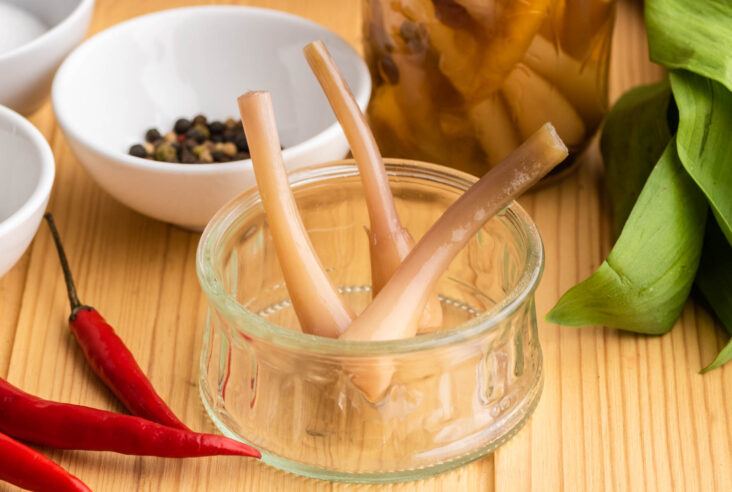
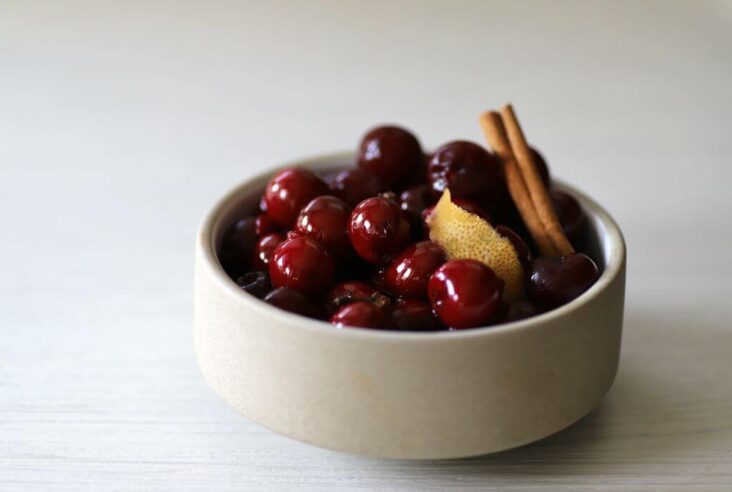
Off to the store to get more white vinegar. Onions and scapes are prepared and waiting. Have dill in the garden. Should be enough. Turmeric will have to use dry. One third amount
Can’t wait to serve at next BBQ
THANK YOU
Awesome! Enjoy your ‘bonus’ garlic harvest and thanks for stopping by!
Not really a dill fan. Can I just leave it out or do I need to try a sweet pickle relish recipe? Love, love garlic scapes! Thanks for this recipe!
Dill is kind of the major flavour in this recipe… you could try it without but it wouldn’t be the same, just sweet and garlicy.
Looking to make this on the weekend. Questions:
What is fresh turmeric?
You have two lines for dill weed: 3 tsp dill weed and then 1 cup dill weed. What do you mean?
Thanks! I grow garlic to sell, but always save some scapes for my own use 🙂
Hi Sheila, that should be 3 tsp dried dill weed and 1 cup fresh dill weed. I like ALL the dill!
Fresh turmeric is a root, it looks similar to ginger but is smaller.
You say 2 lbs of garlic scapes, roughly how many cups do you have once you chop them up. I had 2 lbs of scapes and once chopped didn’t seem to have that much.
Sorry, I do not have a cup measurement for this recipe. Note that there are also 2 cups of chopped onions along with the scapes.
Half cup salt seems like a lot. But no one commented on that, so it must be ok
Reduce it by half if you like Susie.
I really need to grow garlic so I can have garlic scapes! Wow – what a creative recipe for garlic scapes – I’d love this relish on EVERYTHING!
Thanks Terri! We do love it a lot. I’ve been eating it on everything.
Hooray for scapes! Wonderful condiment idea, with loads of versatility and a big, bold flavour (which is a rare combination). Dill is a great idea – it manages to stand up to the powerful taste of the garlic scapes while still complimenting them. Awesome stuff Bernice.
Thank you Sean It is definitely bold in flavour!
This is a great idea! I can imagine that it has a beautiful aroma! Definitely to try!
It sure does…best if everyone has some at the same meal!
Ooh wow what a fabulous idea for relish! This looks and sounds so wonderful…perfect for the garden herbs!
I LOVE my herb garden in the summer. So many delicious options.
I’ve already pinned the recipe and now I’m on the hunt for scapes. I can’t wait to taste the relish. With the dill it will be a great addition to our burgers and franks. I know hubby and our boys will love this.
Local garlic farms? That’s where I get mine. I can’t grow enough to preserve, only enough to eat fresh.
Yes, this is exactly the relish I’ve been looking for! It will work so well with my favorite snacks. Definitely keep this recipe and giving it a try!
Great to hear, Elaine! I hope you enjoy it as much as we do.
This post is making my mouth water. I need to find some scapes and make this relish!
I hope you find some Denise!
I don’t grow garlic in my garden, but a friend does, and I just sent her this recipe. I want some scapes because this relish looks amazing. We love spicy everything, so the addition of gochugaru sounds so good.
mmm, it really goes nicely in this relish. Enjoy!
What an amazing sauce. I’m going to be making it to have with a barbecue, when the weather finally improves here.
sigh. I know how you feel. It’s either uncharacteristically cool here, or it’s hot then stormy. So far, we’ve managed to sneak in a few barbecues amidst the mosquitoes…
This is a great idea and looks so flavourful…will keep a look out for garlic scapes here in
Good luck! Worth searching for…
I can’t grow cucumbers to save my life, so I’m always looking for alternative recipes for relish and pickles. Until today, Zucchini Relish was my favorite, but I think that’s about to change. I adore garlic scapes, so this recipe is going to be added to my canning book. Now, all I have to do is plant hard neck garlic in the fall, so I cam fill up my pantry with this delicious looking relish.
Perfect!! I hope you enjoy the relish.
This would be hard to not eat straight out of the jar! I would love to have this for my macaroni or potato salad this weekend.
Garlic Scape Macaroni Salad will be happening here soon!
This is such a great recipe! So perfect for summer recipes and has so much flavor!! I made a double batch of this!
Yes! I hope you can find the scapes…it’s worth it.
Hmmm I am thinking of having burgers for dinner tonight and this Garlic Scape Relish looks perfect for my dish. Thanks for sharing!
Give it a try! I’m not a sweet relish fan but I do love my garlic dills!
What a GREAT idea. I love garlic scapes. This is the perfect relish for all the summer bbq burgers, sausages….hot dogs. I need to get more scapes now LOL.
We have a local garlic farm that we get scapes from…I bought 9 lbs last year!!